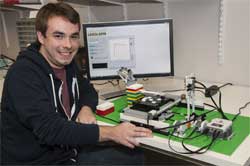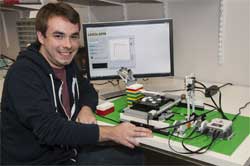 KINGSTON, R.I. – September 28, 2012 – The use of nanotechnology is growing tremendously in numerous science and engineering disciplines, with wide-ranging applications in medicine, electronics and energy. But it is rarely taught at the middle school and high school levels because of a dearth of age-appropriate teaching materials.
KINGSTON, R.I. – September 28, 2012 – The use of nanotechnology is growing tremendously in numerous science and engineering disciplines, with wide-ranging applications in medicine, electronics and energy. But it is rarely taught at the middle school and high school levels because of a dearth of age-appropriate teaching materials.
A University of Rhode Island sophomore has addressed this problem by creating a Lego-based atomic force microscope that helps introduce students to the field of nanotechnology.
Ron Sadlier, a physics and applied math major from Warren, worked under the guidance of Keunhan Park, URI assistant professor of mechanical engineering, to develop the device, which includes Lego bricks, a Lego-Mindstorm controller, a low-power laser and software enabling users to create a 3-D graph of a scanned sample in real-time.
“Nanotechnology is becoming more important to benefit our daily life,” explained Park. “Middle and high school students know about molecules, which are smaller than a nanometer, and they learn about very small stuff in chemistry, physics and biology. But they’re not exposed to nanotechnology education, so that’s what we’re trying to do. We want the younger generation to be prepared for the technology that will become a driving technology of our future for sure.”
“In studying physics, I’m always working on things that you can’t really see with the naked eye, and that’s sort of what nanotechnology is like,” said Sadlier. “I didn’t know anything about atomic force microscopes before I started this project, but it really helped me understand nanotechnology. And if it helped me, it can help other students, too.”
Most students are familiar with the use of optical microscopes, which are commonly used in high school biology classes. To study things too small to be seen by an optical microscope, scientists often turn to atomic force microscopes, which measure or modify the topography of very small samples. Most students are unfamiliar with these devices because they are expensive and often too small to see and understand how they operate.
Park calls the Lego device a good starting point for introducing students how to see objects that are so small he calls them “nano-things.”
With funding from the National Science Foundation, Sadlier and Park hope their Lego atomic force microscope will be met with enthusiasm by the nanotechnology education community, as well as students interested in Lego devices, science and engineering. They plan to invite interested high school students to URI next spring and summer for workshops on nanotechnology during which the participants will build the Lego microscope and then observe how a real atomic force microscope operates. They estimate that users should be able to construct the device in about one hour.
Sadlier and Park have prepared a parts list, guidelines and downloadable software so that anyone interested in building their own Lego atomic force microscopes will be able to do so by visiting http://mcise.uri.edu/park/MNEL/legoafm/index.html.
“I feel like I really pushed Lego to its limits,” said Sadlier. “I’m really happy with the outcome. It exactly copies the mechanism used in the atomic force microscope. And the best part is that it’s all self-contained, so you can set it up and leave the room and let it work on its own. You can worry less about how to operate it and instead focus on what you can learn from it.”
Sadlier said that others have tried to make a similar device out of Lego bricks, but his is the first to integrate with a computer.
“I’m pretty sure that once students start playing with it, they’ll realize how cool nanotechnology really is,” concluded Sadlier. “It will definitely get them interested in science and math.”
URI Marketing & Communications photo by Michael Salerno Photography.

